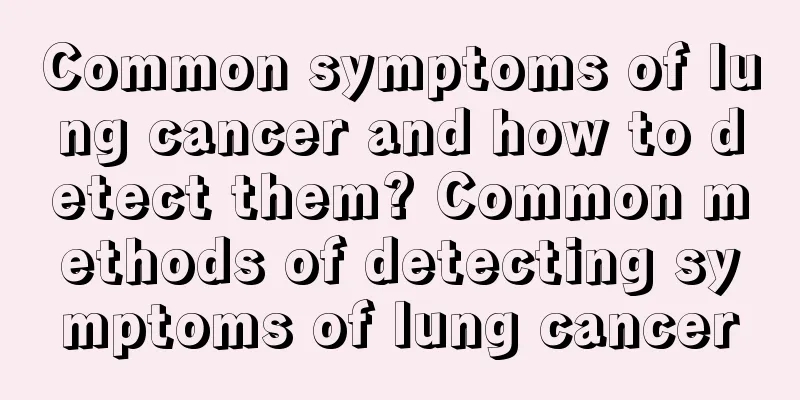What are the symptoms of liver cancer? Can liver cancer be diagnosed by B-ultrasound?

|
As we all know, liver cancer is one of the most common malignant tumors in my country, and its mortality rate is the third most common malignant tumor after gastric cancer and esophageal cancer. In China, about 110,000 people die from liver cancer every year, accounting for 45% of the deaths from liver cancer worldwide. How can we diagnose whether we have liver cancer? What are the symptoms of liver cancer patients? Can liver cancer be diagnosed by B-ultrasound? Liver cancer can be detected through enhanced CT scans. Liver cancer examinations mainly include serum alpha-fetoprotein (AFp) and liver imaging examinations. B-ultrasound can only detect suspicious nodules, while CT or MRI is required for definitive diagnosis. What are the symptoms of liver cancer? Early symptoms: It takes about 2 years for liver cancer to develop from the first cancer cell formation to the onset of conscious symptoms. During these two years, the patient may not show any symptoms or signs. A small number of patients may experience loss of appetite, upper abdominal distension, fatigue, etc., and some patients may have mild liver enlargement. Symptoms in the middle and late stages: Typical symptoms and signs of liver cancer generally appear in the middle and late stages, mainly including liver pain, weight loss, fatigue, jaundice, ascites, etc. 1. Pain in the liver area: The most common type is intermittent, persistent dull pain or bloating. The pain is caused by the rapid growth of the cancer, which tightens the liver capsule and causes the tumor to invade the diaphragm. The pain may radiate to the right shoulder or right back. A tumor growing to the right back may cause right waist pain. Sudden onset of severe abdominal pain and peritoneal irritation signs indicates bleeding under the capsule of the cancer nodule or rupture into the abdominal cavity. 2. Fatigue, weight loss, general weakness. A small number of patients in the late stage of liver cancer may show cachexia symptoms. 3. Gastrointestinal symptoms: decreased appetite, indigestion, nausea, vomiting and diarrhea are easily overlooked due to their lack of specificity. 4. Fever: Generally, the temperature is low, reaching above 39°C, with continuous fever, low fever in the afternoon, or high fever of the remittent type. Fever is related to the absorption of necrotic products of the tumor. Compression or invasion of the bile duct by the tumor may lead to biliary infection. 5. Symptoms of metastatic lesions: There are corresponding symptoms at the place where the tumor metastasizes, which sometimes become the first symptoms of liver cancer. For example, metastasis to the lungs can cause coughing and hemoptysis; pleural metastasis can cause chest pain and bloody pleural effusion; embolism of the pulmonary artery or branches can cause pulmonary infarction, which can cause sudden severe dyspnea and chest pain; blockage of the inferior vena cava by the tumor thrombus can cause severe edema of the lower limbs and even a drop in blood pressure; blockage of the hepatic vein can cause Budd-Chiari syndrome and edema of the lower limbs; metastasis to the bones can cause local pain or pathological fractures; metastasis to the spine or compression of the spinal nerves can cause local pain and paraplegia; intracranial metastasis can cause corresponding localization symptoms and signs, such as intracranial hypertension, which can lead to brain herniation and sudden death. 6. Other systemic symptoms: Endocrine or metabolic syndromes caused by abnormal metabolism of the tumor itself or various effects of cancer tissue on the body are called paraneoplastic syndromes, which sometimes occur before the symptoms of liver cancer itself. Common ones include: liver cancer and portal vein cancer ⑴ Spontaneous hypoglycemia: 10-30% of patients may experience this condition due to the ectopic secretion of insulin or insulin-like substances by liver cells, or the inhibition of insulinase by tumors, or the secretion of a pancreatic β-cell stimulating factor, or excessive glycogen storage; it may also be caused by excessive glucose consumption by liver cancer tissue. In severe cases, it can lead to coma, shock, and death. Correct judgment and timely symptomatic treatment can save patients from death. ⑵ Polycythemia: 2-10% of patients may develop related symptoms that may be caused by increased erythropoietin in the circulation. ⑶ Other rare diseases include hyperlipidemia, hypercalcemia, carcinoid syndrome, early sexual intercourse and gonadotropin secretion syndrome, cutaneous porphyria and dysfibrinogenemia, which may be related to abnormal protein synthesis, ectopic endocrine secretion and porphyrin metabolism disorders in liver cancer tissue. 7. Paraneoplastic syndrome: The abnormal metabolism of the tumor itself affects the body and causes endocrine or metabolic abnormalities, which is called paraneoplastic syndrome. Hypoglycemia and polycythemia are the most common, while other rare syndromes include hyperlipidemia, hypercalcemia, precocious puberty, gonadotropin secretion syndrome, carcinoid syndrome, etc. 8. Signs of liver cancer - jaundice. Jaundice is a common sign of advanced liver cancer. Diffuse liver cancer and cholangiocarcinoma are most likely to cause jaundice. Jaundice is mostly caused by compression of the bile duct or invasion of the bile duct by cancer, or compression of the bile duct by enlarged lymph nodes metastasized from the liver hilum. In a few cases, the liver cancer tissue grows into the bile duct, and the mass blocks the bile duct, causing obstructive jaundice. Although the mortality rate of liver cancer is high, there is still a chance of recovery if it is discovered in the early stage, so you must take good care of your body. If you find early symptoms, you must go to the hospital for a CT scan! You only have one life, so you cannot ignore the details of your body's reaction to the virus. |
<<: How to effectively treat liver cancer? 5 best treatments for liver cancer
Recommend
What should I do if my heart often stops beating in the late stage of lung cancer?
If patients with advanced lung cancer suddenly ex...
What milk powder contains lactoferrin
Nowadays, many milk powders are rich in lactoferr...
How to effectively treat pancreatic cancer ascites
Many diseases may damage body organs and cause ot...
Is brown sugar effective in removing freckles?
Using brown sugar to remove freckles is actually ...
What is Cardiac Cancer? What are the symptoms of Cardiac Cancer?
There are many types of cancer, which poses a gre...
The embryo is developing well
Whether the embryo is developing well is somethin...
What fruits are good for the elderly with osteosarcoma?
Although osteosarcoma often occurs in young peopl...
What are the early symptoms of liver cancer? The 4 most obvious symptoms of early liver cancer
Experts point out that if you find yourself exper...
The correct way to remove moles with white vinegar, teach you two kinds
Many people feel that the moles on their faces ar...
Putting ginger in the navel has an effect
Ginger is a widely used ingredient in people'...
Antithrombin is high
Antithrombin is a relatively important substance ...
What chemotherapy drugs should I take after colon cancer surgery
What chemotherapy drugs should be taken after col...
How can you make your teeth whiter?
There are many different colors of teeth, but the...
Harm of silicon phosphorus crystal to human body
Some silicon phosphorus crystal products are used...
What are the treatments for constipation
Perhaps you often have this situation: you haven&...









